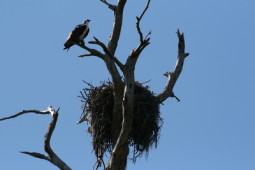 It’s late April, and all over the northern hemisphere ospreys are arriving at their summer homes after a long migration. Males and females usually arrive separately and whoever gets to the nest first begins the task of tidying up. A lot of time is spent rearranging the furniture – er, sticks – and lining the nest with fresh grasses.
It’s late April, and all over the northern hemisphere ospreys are arriving at their summer homes after a long migration. Males and females usually arrive separately and whoever gets to the nest first begins the task of tidying up. A lot of time is spent rearranging the furniture – er, sticks – and lining the nest with fresh grasses.
Ospreys use the same nest every year and may be more attached to their nest than their mate. Young ospreys will eventually return to the area where they hatched and build a new nest. In the beginning, the nest is fairly small, maybe less than a metre (3 feet) in diameter. But each year, the energetic ospreys add to it, sometimes creating a gigantic nest 3 – 4 metres (10-13 feet) in diameter. That’s big enough to hold a SmartCar!
The nest site is selected carefully and it’s all about location. The nest must be near an adequate supply of fish, either a pond, lake, ocean or stream, so Mom and Dad don’t have to fly too far when bringing dinner home to their hungry chicks. The nest must be safe from ground predators, like raccoons and snakes. It must be open for easy approach and so dangers from the air, like eagles, can be easily seen. Ospreys often build on treetops, snags, cliffs, channel markers, light standards and cell towers.
 Urban nests can be a problem. Ospreys aren’t shy of human activity and will take advantage of prime conditions – like the two man-made lakes near my house, which are annually stocked
Urban nests can be a problem. Ospreys aren’t shy of human activity and will take advantage of prime conditions – like the two man-made lakes near my house, which are annually stocked  with 6,000 lbs of trout. But nests on power poles can cause big troubles with the delivery of electricity. Progress Energy says ospreys in Florida crash the electrical system about 65 times a year during nesting season. In 1997, a nest on a utility pole near Orlando exploded in flames, closing
with 6,000 lbs of trout. But nests on power poles can cause big troubles with the delivery of electricity. Progress Energy says ospreys in Florida crash the electrical system about 65 times a year during nesting season. In 1997, a nest on a utility pole near Orlando exploded in flames, closing  traffic on the freeway. It seems crazy to build a nest just a few feet above power lines that are humming with 100,000 volts of electricity, but ospreys do it.
traffic on the freeway. It seems crazy to build a nest just a few feet above power lines that are humming with 100,000 volts of electricity, but ospreys do it.
To prevent massive power outages, unhappy customers, and injured birds, power companies now identify troublesome nests and relocate them to man-made nesting platforms erected nearby. And sometimes the technicians attach a nestcam so we can keep an eye on the birds.
Video: Exclusive 300-pound osprey nest moved from power pole
My book, Ospreys in Danger, is a fictional account of real power-pole fire that happened in Waterton Lakes National Park. This entry in the Park Warden’s log sparked my curiosity:
May 16, 1977 Two mated ospreys attempted to build nest on top of double power pole. Birds shorted out line which caught nest on fire, fortunately the ospreys were not killed.
Ospreys in Danger is an early chapter book for kids 7 – 10 years old. It’s an ecological adventure with lots of information about ospreys – perfect for a budding naturalist!
